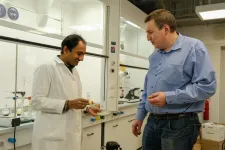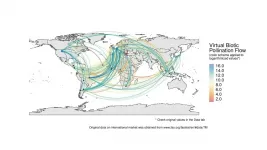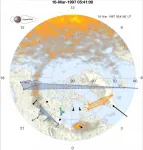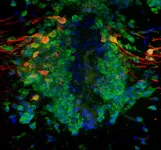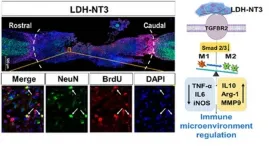(Press-News.org) An international group of researchers led by the University of Adelaide has conducted a comprehensive genetic analysis and found no evidence of interbreeding between modern humans and the ancient humans known from fossil records in Island Southeast Asia. They did find further DNA evidence of our mysterious ancient cousins, the Denisovans, which could mean there are major discoveries to come in the region.
In the study published in Nature Ecology and Evolution, the researchers examined the genomes of more than 400 modern humans to investigate the interbreeding events between ancient humans and modern human populations who arrived at Island Southeast Asia 50,000-60,000 years ago.
In particular, they focused on detecting signatures that suggest interbreeding from deeply divergent species known from the fossil record of the area.
The region contains one of the richest fossil records (from at least 1.6 million years) documenting human evolution in the world. Currently there are three distinct ancient humans recognised from the fossil record in the area: Homo erectus, Homo floresiensis (known as Flores Island hobbits) and Homo luzonensis.
These species are known to have survived until approximately 50,000-60,000 years ago in the cases of Homo floresiensis and Homo luzonensis, and approximately 108,000 years for Homo erectus, which means they may have overlapped with the arrival of modern human populations.
The results of the study showed no evidence of interbreeding. Nevertheless, the team were able to confirm previous results showing high levels of Denisovan ancestry in the region.
Lead author and ARC Research Associate from the University of Adelaide Dr João Teixeira, said: "In contrast to our other cousins the Neanderthals, which have an extensive fossil record in Europe, the Denisovans are known almost solely from the DNA record. The only physical evidence of Denisovan existence has been a finger bone and some other fragments found in a cave in Siberia and, more recently, a piece of jaw found in the Tibetan Plateau."
"We know from our own genetic records that the Denisovans mixed with modern humans who came out of Africa 50,000-60,000 years ago both in Asia, and as the modern humans moved through Island Southeast Asia on their way to Australia.
"The levels of Denisovan DNA in contemporary populations indicates that significant interbreeding happened in Island Southeast Asia.
"The mystery then remains, why haven't we found their fossils alongside the other ancient humans in the region? Do we need to re-examine the existing fossil record to consider other possibilities?"
Co-author Chris Stringer of the Natural History Museum in London added:
"While the known fossils of Homo erectus, Homo floresiensis and Homo luzonensis might seem to be in the right place and time to represent the mysterious 'southern Denisovans', their ancestors were likely to have been in Island Southeast Asia at least 700,000 years ago. Meaning their lineages are too ancient to represent the Denisovans who, from their DNA, were more closely related to the Neanderthals and modern humans."
Co-author Prof Kris Helgen, Chief Scientist and Director of the Australian Museum Research Institute, said: "These analyses provide an important window into human evolution in a fascinating region, and demonstrate the need for more archaeological research in the region between mainland Asia and Australia."
Helgen added: "This research also illuminates a pattern of 'megafaunal' survival which coincides with known areas of pre-modern human occupation in this part of the world. Large animals that survive today in the region include the Komodo Dragon, the Babirusa (a pig with remarkable upturned tusks), and the Tamaraw and Anoas (small wild buffalos).
"This hints that long-term exposure to hunting pressure by ancient humans might have facilitated the survival of the megafaunal species in subsequent contacts with modern humans. Areas without documented pre-modern human occurrence, like Australia and New Guinea, saw complete extinction of land animals larger than humans over the past 50,000 years."
Dr Teixeira said: "The research corroborates previous studies that the Denisovans were in Island Southeast Asia, and that modern humans did not interbreed with more divergent human groups in the region. This opens two equally exciting possibilities: either a major discovery is on the way, or we need to re-evaluate the current fossil record of Island Southeast Asia."
"Whichever way you choose to look at it, exciting times lie ahead in palaeoanthropology."
INFORMATION:
TALLAHASSEE, Fla. -- Scientists peering into the beating heart have solved a decades-old, fundamental mystery about how the heart works. The revelation could herald the development of new treatments for heart diseases -- the leading cause of death worldwide.
Researchers from Eastern Virginia Medical School, Florida State University and the University of Virginia have observed a tiny muscle filament during a crucial stage in a beating heart for the first time. The research was published in Proceedings of the National Academy of Sciences.
The heart is a unique muscle which contracts and relaxes about once every second ...
PROVIDENCE, R.I. [Brown University] -- The COVID-19 pandemic has had devastating effects in U.S. nursing homes and long-term care facilities, resulting in an estimated 1.2 million infections and 147,000 deaths as of early 2021. Yet even as mortality rates in the general population have decreased over time, little evidence has been uncovered to determine whether nursing home residences have experienced similar reductions.
Now, new data collected and analyzed by researchers at Brown University shows that mortality rates among nursing home residents with COVID-19 declined from March to November 2020, and that the deadliest ...
An international group of scientists from India and Russia has created edible food films for packaging fruits, vegetables, poultry, meat, and seafood. Films consist of natural ingredients, they are safe for health and the environment. In addition, films are water-soluble and dissolve by almost 90% in 24 hours. Description of the research and results of experiments are published in the Journal of Food Engineering.
"We have created three types of food films based on the well-known naturally occurring seaweed biopolymer sodium alginate," said Rammohan Aluru, senior researcher Organic synthesis laboratory at Ural Federal University and co-author of the paper. "Its molecules have film-forming ...
Recently, a published study in Science Advances assessed the contribution of pollinators to international market flows and showed that biodiversity conservation is essential to sustain global consumption patterns. This study results from the work of an interdisciplinary team that integrated researchers across the fields of economics, ecology, environmental sciences and social sciences.
Given the growing global demand for crops, sustainability in agriculture is one of the main challenges for human society. Together with the excessive use of chemical inputs, the loss of natural habitat associated with cropland expansion is one of the main drivers ...
Philadelphia, March 23, 2021 - Researchers from Children's Hospital of Philadelphia (CHOP) have discovered that a widely used nutritional supplement may significantly reduce the risk of fatal strokes caused by a rare genetic disorder. Additionally, the findings suggest that the supplement could be used to both block precipitation of and break up the formation of amyloid plaque deposits, a common feature found in serious forms of dementia. The findings were published online today by the journal Nature Communications.
The findings centered around a genetic disorder known as hereditary cystatin C amyloid angiopathy (HCCAA). HCCAA is part ...
Evolution of auroral substorms revealed by physicists at University of Warwick using the same methods that link people through social media
'If you like this magnetometer, you might like this one too:' historical data from magnetometers used to match them with 'like-minded friends' during 41 substorms
Shows that a single coherent electrical current, that accompanies the Northern Lights during substorms, covers most of the Earth's night-side at high latitudes
Will help to validate models used to predict auroral substorms, which can disrupt electronics and power distribution systems
Space weather often manifests as substorms, where a beautiful auroral display such as the Northern Lights is accompanied ...
A pioneering study, published in Scientific Reports, found that the Parkinon's gene PINK1 is important for the generation of dopamine-producing neurons throughout life, and is not just responsible for the premature death of these neurons
The international research, led by University of Sheffield's Neuroscience Institute, used two model systems to examine how neurons are produced throughout our lifetime
Parkinson's disease is a relentlessly progressive neurodegenerative disorder that affects around 145,000 people in the UK
A gene defect linked to Parkinson's disease may not only cause the early death of neurons, ...
Hennigsdorf/Berlin, Germany, March 23, 2021 - Diagnostics company SphingoTec GmbH ("SphingoTec") announced today the first published data (1) on the biomarker DPP3 that can predict the evolution of organ function and survival in septic patients. Measured on top of routinely used standard parameters, such as Lactate and Procalcitonin, DPP3 is an early indicator of short-term outcomes and patient severity. Sepsis is a medical emergency caused by a dysregulated host response to an infection, with mortality rates increasing rapidly for each hour that appropriate treatment is delayed (2). The rapid evolution of sepsis into its severe form, septic shock, raises the need for more precise and faster testing to support better clinical decision-making.
DPP3 is an ...
Researchers from the Department of Orthopedics of Tongji Hospital at Tongji University in Shanghai have successfully used a nanobiomaterial called layered double hydroxide (LDH) to inhibit the inflammatory environment surrounding spinal cord injuries in mice, accelerating regeneration of neurons and reconstruction of the neural circuit in the spine. The researchers were also able to identify the underlying genetic mechanism by which LDH works. This understanding should allow further modification of the therapy which, in combination with other elements, could finally produce a comprehensive, clinically applicable system for spinal cord injury relief in humans.
The ...
Researchers at the University of Toronto have found that food industry interactions with government heavily outnumbered non-industry interactions on Bill S-228, also known as the Child Health Protection Act, which died in the Senate of Canada in 2019.
The researchers looked at more than 3,800 interactions, which included meetings, correspondence and lobbying, in the three years before the bill failed. They found that over 80 per cent were by industry, compared to public health or not-for-profit organizations.
They also found that industry accounted for over 80 per cent of interactions with the highest-ranking government offices, including elected parliamentarians and their staff and unelected ...

